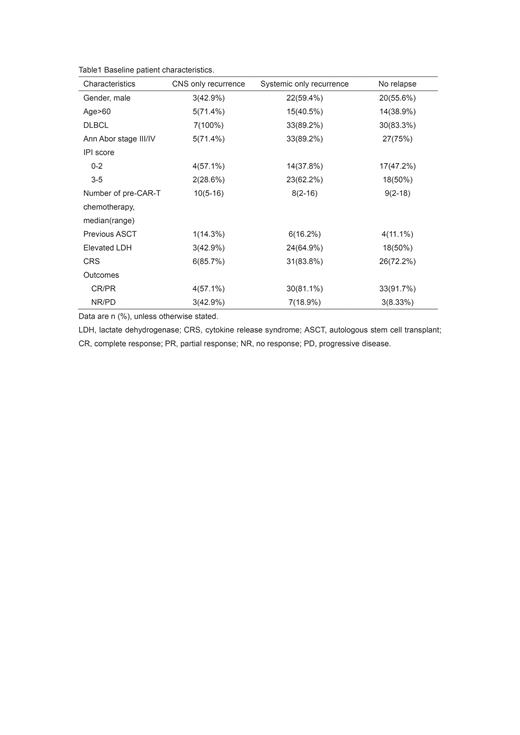Background
CD19-targeted chimeric antigen receptor T (CAR-T) cell therapy has shown remarkable antitumor activity against relapsed/refractory (R/R) non-Hodgkin lymphoma (NHL). However, NHL with central nervous system (CNS) relapse carries a poor prognosis and high mortality. We reported an analysis of 80 patients with NHL who underwent CAR-T cell therapy, and described the characteristics including the international prognostic index (IPI) and other clinical variables to evaluate the outcomes of CNS relapse in NHL patients treated with CAR-T cell therapy.
Methods
A total of 80 patients with NHL treated with CD19 CAR-T cell therapy in our center between April 2017 and November 2022 was retrospectively analyzed. Patient characteristics, laboratory parameters, and clinical outcomes were collected. CNS relapse was diagnosed by cerebrospinal fluid cytology, MRI or PET-CT.
Results
Baseline characteristics of all 80 patients are summarized in Table 1. The median age was 58.5 (range, 10 to 79) years, and 57.5% of patients were male. Overall, 67 (83.8%) patients achieved complete remission (CR) or partial remission (PR) after CD19 CAR-T therapy. Seven (8.43%) patients developed isolated CNS relapse after CAR-T cell therapy, all of which were heavily pre-treated with multiple lines of chemotherapy prior to CAR-T cell therapy, and one of them had received autologous stem cell transplant before infusion of CAR-T cells. Only 4 of 7 patients with isolated CNS relapse achieved CR (n=4), and the median time to isolated CNS relapse from CAR-T cell infusion was 6.3(range, 1.53 to 25.8) months. Thirty-seven patients (46.2%) developed systemic recurrence without CNS involvement, with the median time from CAR-T to relapse of 3.2 (range, 0.467-30.8) months. The other 36 patients remained in remission at the last follow-up.
During the median follow-up of 13.5 months of the whole cohort, the number of recorded deaths in isolated CNS relapse, systemic only recurrence, and no relapse patients was 5 (71.4%), 22 (59.4%), 1(2.78%), respectively. The 1-year OS and 1-year PFS of patients with isolated CNS recurrence was significantly lower compared to the no relapse group (OS, 35.7% [95%CI 12.1-100] vs 97.22% [95%CI 92-100], P<0.001; PFS, 28.6% [95%CI 8.86-92.2] vs 100% [95%CI 100-100], P<0.001), but showed no difference compared to the systemic only recurrence group(OS, 53.3% [95%CI 39.3-72.4], P=0.79; PFS, 13.0% [95%CI 5.53-30.5], P=0.17).
Conclusion
In conclusion, patients with CNS relapse showed significant difference in 1-year outcomes with no relapse group but not systemic relapse group in our study, which suggested the importance of effective prophylaxis against CNS relapse. Further investigation is necessary to better define the characteristics of patients who will benefit from prophylaxis.
Acknowledgements
We gratefully thank all the participation from patients enrolled in clinical trials (ChiCTR1800015575; NCT03118180; NCT04532281; NCT04532268; NCT04213469).
Disclosures
No relevant conflicts of interest to declare.


This feature is available to Subscribers Only
Sign In or Create an Account Close Modal